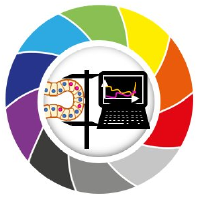Quantitative segmentation quality estimation¶
Often we face the problem, that we have an annnotated image of some data and a segmented version of the same image, which was obtained with some segmentation pipeline (StarDist, EPySeg, PlantSeg, etc). This notebook provides a method to compare the overlap of both ground truth image and achieved segmentation.
[1]:
import os
import biapol_utilities as biau
from skimage import io, measure, segmentation
import numpy as np
import matplotlib.pyplot as plt
from mpl_toolkits.axes_grid1 import make_axes_locatable
import pandas as pd
%matplotlib notebook
Input data¶
First, let’s generate some example data!
[2]:
blobs = biau.data.blobs()
Let’s segment this and take it as a ground truth image:
[3]:
threshold = 128
imageA = (blobs > threshold).astype(np.uint8)
ground_truth = measure.label(imageA)
plt.imshow(ground_truth)
plt.title('Ground truth')
[3]:
Text(0.5, 1.0, 'Ground truth')
Next, we shuffle the labels and expand them a bit:
[4]:
# First, shuffle randomly
label_shuffle = np.arange(1, ground_truth.max()+1, 1)
np.random.shuffle(label_shuffle)
label_shuffle = np.append(np.asarray([0]), label_shuffle) # append 0 at start of array - we don't want to shuffle background
segmented = label_shuffle[ground_truth]
[5]:
# Second, expand the labels a bit
segmented = segmentation.expand_labels(segmented, 5)
[6]:
# Plot side by side
fig, axes = plt.subplots(ncols=2, sharex=True, sharey=True)
axes[0].imshow(ground_truth)
axes[0].set_title('Ground truth')
axes[1].imshow(segmented)
axes[1].set_title('Segmentation')
[6]:
Text(0.5, 1.0, 'Segmentation')
Re-match labels¶
Next, use the label-matching from biapol_utilities to assign correct labels to both images
[7]:
segmented = biau.label.match_labels(ground_truth, segmented)
[8]:
# Plot side by side
fig, axes = plt.subplots(ncols=2, sharex=True, sharey=True)
axes[0].imshow(ground_truth)
axes[0].set_title('Ground truth')
axes[1].imshow(segmented)
axes[1].set_title('Segmentation')
[8]:
Text(0.5, 1.0, 'Segmentation')
Compare labels: Labelwise Jaccard-index¶
Lastly, we calculate the label-wise Jaccard index to measure the intersection over union (IoU) between corresponding pairs of labels.
[9]:
result = biau.label.compare_labels(ground_truth, segmented)
result
[9]:
| label | jaccard_score | dice_score | |
|---|---|---|---|
| 0 | 0 | 0.496847 | 0.663858 |
| 1 | 1 | 0.518102 | 0.682566 |
| 2 | 2 | 0.470130 | 0.639576 |
| 3 | 3 | 0.623552 | 0.768133 |
| 4 | 4 | 0.602546 | 0.751986 |
| ... | ... | ... | ... |
| 63 | 63 | 0.262857 | 0.416290 |
| 64 | 64 | 0.000000 | 0.000000 |
| 65 | 65 | 0.000000 | 0.000000 |
| 66 | 66 | 0.000000 | 0.000000 |
| 67 | 67 | 0.000000 | 0.000000 |
68 rows × 3 columns
Let’s also visualize this: To do this, we create a new image and assign the jaccard-index result value to every pixel depending on the label.
[10]:
LUT_jaccard = result['jaccard_score'].to_numpy()
LUT_dice = result['dice_score'].to_numpy()
# set segmentation quality of background to zero
LUT_jaccard[0] = np.nan
LUT_dice[0] = np.nan
# create score map
JI_map = LUT_jaccard[segmented]
DI_map = LUT_dice[segmented]
[11]:
# Plot side by side
fig, axes = plt.subplots(nrows=2, ncols=3, sharex=True, sharey=True, figsize=(10,5))
fig.subplots_adjust(left=0.05, bottom=0.06, right=0.85, top=0.95, wspace=0.05)
# Plot ground truth
axes[0, 0].imshow(ground_truth)
axes[0, 0].set_title('Ground truth')
# Plot segmentation
axes[0, 1].imshow(segmented)
axes[0, 1].set_title('Segmentation')
# Plot overlay
axes[0, 2].imshow(ground_truth)
axes[0, 2].imshow(segmented, alpha=0.5)
axes[0, 2].set_title('Overlay')
# Plot Jaccard index map
im = axes[1, 0].imshow(JI_map, cmap='inferno_r')
axes[1, 0].set_title('Jaccard score')
cbar = fig.colorbar(im, ax=axes[1, 0])
# Plot Dice score map
im2 = axes[1, 1].imshow(DI_map, cmap='inferno_r')
axes[1, 1].set_title('Dice score')
cbar2 = fig.colorbar(im2, ax=axes[1, 1])
axes[-1, -1].axis('off')
[11]:
(-0.5, 255.5, 253.5, -0.5)
Compare-labels: Feature-wise¶
It may be an interesting approach to not only check the pixel-wise agreement between segmentation and annnootation but to also check whether certain features are preserved in the segmentation. For this, the (shape-) features are calculated in both ground_truth annotation and segmented image with scikit-image regionprops.
[12]:
properties = ['label', 'area', 'eccentricity', 'orientation']
features_gt = measure.regionprops_table(ground_truth, properties=properties)
features_seg = measure.regionprops_table(segmented, properties=properties)
features_gt = pd.DataFrame(features_gt)
features_seg = pd.DataFrame(features_seg)
features_gt
[12]:
| label | area | eccentricity | orientation | |
|---|---|---|---|---|
| 0 | 1 | 415 | 0.878888 | -0.433915 |
| 1 | 2 | 181 | 0.822705 | -1.513862 |
| 2 | 3 | 646 | 0.386542 | -0.079653 |
| 3 | 4 | 426 | 0.324798 | -0.400592 |
| 4 | 5 | 465 | 0.780472 | -0.044317 |
| ... | ... | ... | ... | ... |
| 58 | 59 | 1 | 0.000000 | 0.785398 |
| 59 | 60 | 87 | 0.969263 | -1.560717 |
| 60 | 61 | 73 | 0.951468 | -1.567605 |
| 61 | 62 | 49 | 0.942191 | -1.554054 |
| 62 | 63 | 46 | 0.976786 | 1.538848 |
63 rows × 4 columns
Visualize as histograms
[13]:
fig, axes = plt.subplots(nrows=1, ncols=len(properties)-1, figsize=(9,6))
ax_idx = 0
for idx, prop in enumerate(properties):
if prop == 'label':
continue
axes[ax_idx].hist(features_gt[prop], label='ground_truth', bins=20, alpha=0.5)
axes[ax_idx].hist(features_seg[prop], label='segmentation', bins=20, alpha=0.5)
axes[ax_idx].set_xlabel(prop)
ax_idx += 1
axes[0].legend()
axes[0].set_ylabel('# Occurrences')
[13]:
Text(0, 0.5, '# Occurrences')
[ ]:
